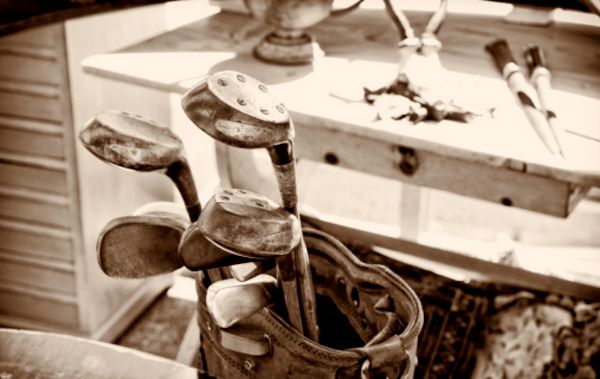Names – Old golf clubs
In the days when all golf clubs were painstakingly hand-made, sometimes by a professional clubmaker, but sometimes by the local blacksmith, clubs were far from standardised. Each was a unique creation, and the clubs were given names, not numbers. The practice of giving numbers to irons only began in the mid-1920s in the US, as industrial production began to take over, and for wooden clubs – usually carved from solid blocks – it took even longer.
Comparing antique and modern golf clubs is therefore almost impossible. Many old clubs would be illegal today (e.g. the rake iron and water iron), and some would have no purpose today (e.g. the rutting iron).
Names – Old golf clubs
Some clubs had names closely allied to their purpose, for example the ‘jigger’. Everyone agrees that the jigger is a club used for approach work around the greens, but – just as today – some people see these shots as lofted pitches, but others see them as bump and runs. So certain jiggers will resemble a modern wedge, but others will resemble a much straighter faced iron.
Next time you’re golfing at Gullane why not make an appointment to visit our wonderful Heritage of Golf Museum: from featheries to hickory, gutta percha to mashie niblicks, anyone with an interest in the history of the great game will love this Aladdin’s cave of golf treasures. pic.twitter.com/GuZmETwpEH
— Gullane Golf Club (@GullaneGolfClub) October 3, 2018
Names – Old golf clubs
For that matter, even modern club designations can be misleading over time. Take the 5 iron and the 9 iron. In the 1970s, these would have had about 30° and 46° of loft; the 2012 versions of the ‘same’ clubs have probably 26° and 41°.
With all these caveats, the list below attempts to give the most generally accepted equivalences. You have been warned!
Names – Old golf clubs
| Modern Club | Nearest Antique Equivalent |
| Driver | Driver |
| 2 wood | Brassie |
| 3 wood | Spoon |
| 4 wood | Baffy, baffie, baffing spoon, wooden cleek |
| 1 iron | Driving iron, cleek |
| 2 iron | Mid iron |
| 3 iron | Mid mashie |
| 4 iron | Mashie iron, jigger |
| 5 iron | Mashie |
| 6 iron | Spade mashie |
| 7 iron | Mashie niblick |
| 8 iron | Lofting iron |
| 9 iron | Niblick |
| Wedge | Pitching niblick, jigger, chipper |
| Putter | Putter |
Originally posted in 2012
